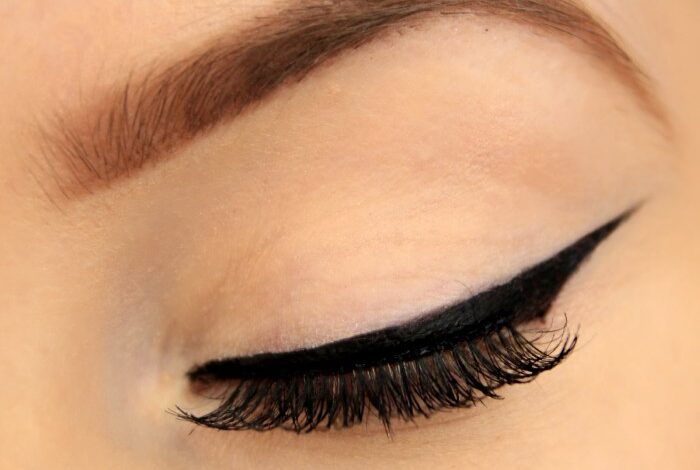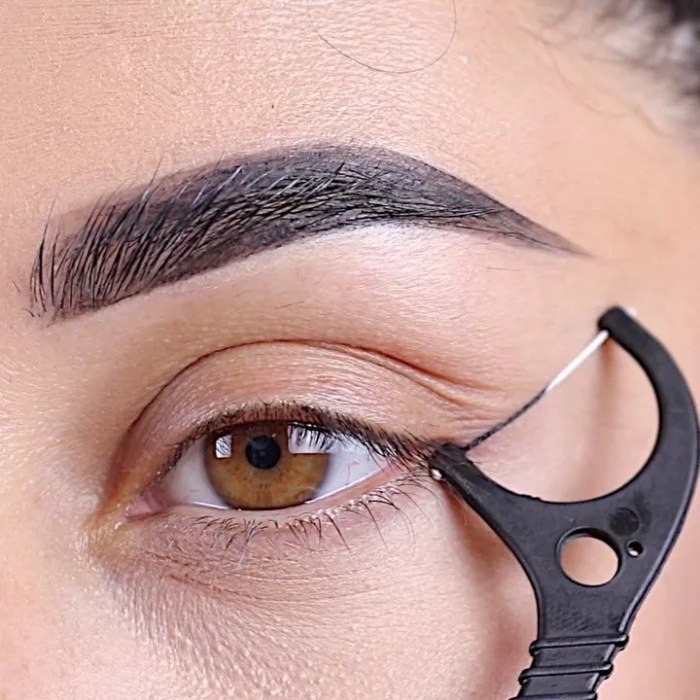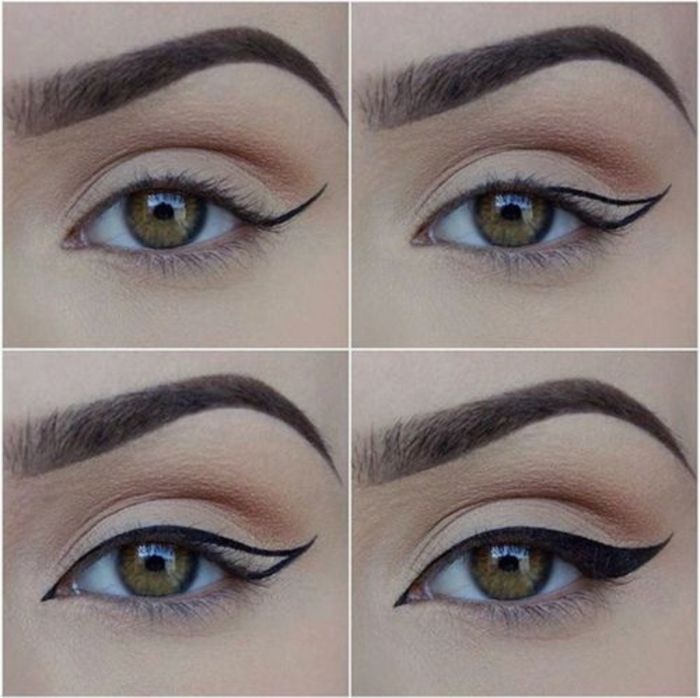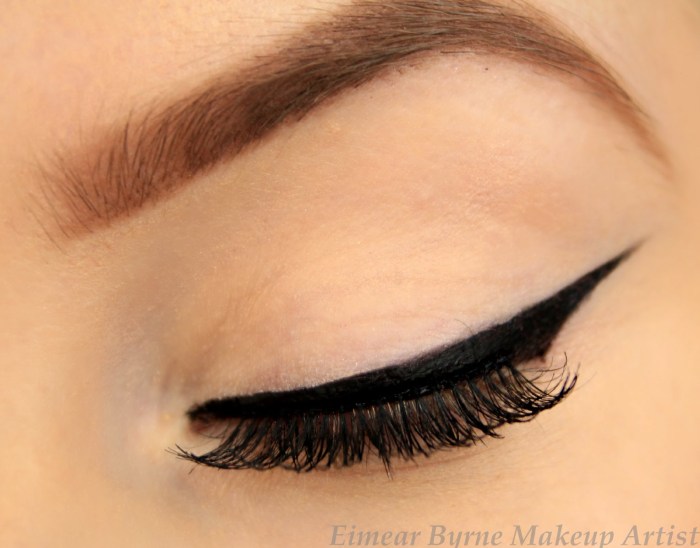
How to Perfect Winged Eyeliner: Your Guide to Flawless Wings
How to perfect winged eyeliner takes center stage, and we’re diving into a world where precision meets artistry. Mastering this classic makeup technique is all about finding the right tools, understanding your eye shape, and embracing a few key tips and tricks.
From choosing the perfect eyeliner to creating a symmetrical wing that complements your features, this guide will equip you with the knowledge and confidence to achieve flawless, winged eyeliner every time.
Whether you’re a seasoned makeup enthusiast or just starting your beauty journey, winged eyeliner can instantly elevate your look, adding a touch of drama and sophistication. Let’s embark on a journey to unlock the secrets of achieving the perfect winged eyeliner, and unleash your inner makeup artist!
Understanding Winged Eyeliner
Winged eyeliner is a classic makeup technique that can instantly enhance your eye shape and create a dramatic, alluring look. From subtle flicks to bold, graphic lines, there are countless ways to personalize your winged eyeliner.
Different Types of Winged Eyeliner Styles
The type of winged eyeliner you choose can significantly impact the overall look. Here are some popular styles:
- Classic Winged Eyeliner:This timeless style features a thin line that extends outward from the outer corner of the eye, creating a sharp, angled wing.
- Cat Eye:This style is similar to the classic wing but with a more dramatic and elongated flick, giving the appearance of a cat’s eye.
- Double Winged Eyeliner:This style involves creating two wings, one on the top lash line and another on the bottom lash line, for a bolder and more dramatic look.
- Graphic Eyeliner:This style uses bold, geometric shapes and lines to create a statement look.
- Thick Winged Eyeliner:This style features a thicker line and wing for a more intense and dramatic look.
Choosing the Right Eyeliner
The type of eyeliner you choose is crucial for achieving the desired look and staying power.
- Liquid Eyeliner:Liquid eyeliner offers the most precise application and allows for a sharp, defined wing. It is typically long-lasting and comes in various finishes, such as matte, shimmer, and glitter.
- Gel Eyeliner:Gel eyeliner provides a smooth, creamy texture that is easy to blend. It is a versatile option that can be used to create both thin and thick lines.
- Pencil Eyeliner:Pencil eyeliner is a great option for beginners as it is easy to apply and smudge. It is also a good choice for creating a softer, more natural look.
- Felt Tip Eyeliner:Felt tip eyeliner is similar to liquid eyeliner but comes in a felt-tip pen. It is a good option for those who prefer a more controlled application.
Prepping the Eyelids for Winged Eyeliner Application
Properly prepping your eyelids is essential for achieving a flawless winged eyeliner application.
- Apply a Primer:Using an eyeshadow primer helps to create a smooth base for the eyeliner and prevents it from smudging or fading.
- Conceal and Set:Concealing any dark circles or imperfections around the eyes helps to create a clean canvas for the eyeliner. Set the concealer with a translucent powder to prevent the eyeliner from bleeding.
- Use a Tape Guide (Optional):If you are new to winged eyeliner, using a tape guide can help you achieve a symmetrical and precise wing.
Essential Tools and Techniques

The right tools and techniques are essential for achieving the perfect winged eyeliner. A variety of eyeliner products and application tools are available, each with its own advantages and disadvantages. Choosing the right tool for your skill level and desired look is crucial.
Mastering winged eyeliner is all about precision and a steady hand, but let’s be real, a smooth canvas makes all the difference. That’s where taking care of your skin comes in! A great skincare routine, like the one you can find get better skin here, will help create a flawless base for your winged eyeliner masterpiece.
Once you’ve got that radiant glow, you’ll be ready to slay those wings with confidence.
Choosing the Right Eyeliner
Eyeliner products come in various forms, each with its own unique characteristics. Consider these factors when choosing your eyeliner:
- Liquid Eyeliner: Liquid eyeliner is known for its intense color payoff and sharp lines. It’s ideal for creating precise and dramatic wings. However, it can be challenging to apply for beginners, as it dries quickly and requires a steady hand.
Mastering winged eyeliner takes practice, just like perfecting any craft. It’s all about finding the right angle and technique. Speaking of techniques, have you seen those adorable fall quiet book patterns ? They’re so intricate and calming, kind of like the precision required for a perfect winged liner.
Once you’ve nailed your winged eyeliner, you’ll be ready to tackle any creative challenge, from crafting to making those intricate quiet book patterns.
- Gel Eyeliner: Gel eyeliner offers a balance between precision and ease of application. It’s typically housed in a small pot and applied with a brush. Gel eyeliner allows for more control and is easier to blend than liquid eyeliner.
It dries slightly slower, giving you more time to adjust the wing.
- Pencil Eyeliner: Pencil eyeliner is the most forgiving option, perfect for beginners. It’s easy to apply and blend, making it ideal for creating softer, less dramatic looks. However, pencil eyeliner may not be as precise as liquid or gel eyeliner.
Applying Eyeliner
Once you’ve chosen your eyeliner, the next step is mastering the application technique. The following tips will help you create a flawless wing:
- Prepare Your Eyes: Before applying eyeliner, ensure your eyelids are clean and free of any oils or makeup. Consider using a primer to create a smooth canvas for your eyeliner.
- Start with a Thin Line: Begin by drawing a thin line along your lash line, working from the inner corner to the outer corner of your eye.
- Create the Wing: Extend the line from the outer corner of your eye upwards, creating a diagonal line that matches the shape of your lower lash line.
- Connect the Lines: Once you’ve created the wing, connect it to the line along your lash line.
- Fill in the Wing: Fill in the space between the lines to create a solid, defined wing.
- Clean Up Any Mistakes: Use a cotton swab dipped in makeup remover to clean up any smudges or mistakes.
Tips for Achieving a Sharp Wing
Achieving a sharp and precise wing requires practice and patience. Here are some tips to help you perfect your winged eyeliner:
- Use a Steady Hand: Rest your elbow on a surface to stabilize your hand while applying eyeliner.
- Use a Mirror: Use a magnifying mirror to help you see your eye clearly.
- Practice Makes Perfect: Practice applying winged eyeliner on a daily basis. The more you practice, the easier it will become.
- Start Small: Begin with a thin wing and gradually increase the size as you become more comfortable.
- Use a Guide: If you’re struggling to create a symmetrical wing, use a guide such as a credit card or a piece of tape to help you create a straight line.
Tools for Precise Application, How to perfect winged eyeliner
| Tool | Description | Pros | Cons |
|---|---|---|---|
| Liquid Eyeliner Brush | A thin, angled brush designed for applying liquid eyeliner. | Provides precise application and sharp lines. | Can be difficult to control for beginners. |
| Gel Eyeliner Brush | A small, angled brush designed for applying gel eyeliner. | Offers more control than liquid eyeliner brushes. | Can be difficult to clean. |
| Pencil Eyeliner Sharpener | A sharpener specifically designed for sharpening pencil eyeliner. | Keeps pencil eyeliner sharp and precise. | Can be messy if not used properly. |
| Cotton Swabs | Small, cotton-tipped applicators used for cleaning up mistakes. | Easy to use and effective at removing eyeliner. | Can smudge eyeliner if not used carefully. |
Creating the Perfect Wing: How To Perfect Winged Eyeliner

The wing is the defining element of winged eyeliner, adding that dramatic and alluring touch. Mastering the wing requires practice and a steady hand, but with the right techniques and tools, you can achieve a flawless, symmetrical wing.
Mastering winged eyeliner takes practice, but once you nail it, you’ll feel like a makeup pro! It’s all about finding the right angle and technique, and I find it helps to have a good outfit on to boost my confidence – I’m all about those favorite workout outfits that make me feel ready to conquer anything, even a tricky eyeliner wing! Once you’ve got your winged liner down, it’s time to show it off!
Methods for Creating the Wing
Different methods can help you create the perfect wing, each with its own set of advantages and disadvantages.
- Using Tape: This method provides a precise edge for your wing and is particularly helpful for beginners. Apply a piece of tape along your outer lash line, extending it outwards in the direction you want your wing to go. Then, use your eyeliner to draw along the tape, creating a sharp and defined wing.
Once the eyeliner is dry, carefully remove the tape.
- Using a Spoon: This method utilizes the curve of a spoon to create a smooth, rounded wing. Place the back of a spoon along your outer lash line, angling it upwards to create the desired wing shape. Use your eyeliner to trace the edge of the spoon, creating a soft and curved wing.
- Freehand: For those who prefer a more natural and less rigid look, freehanding is a great option. Start by drawing a small line at the outer corner of your eye, angling it upwards towards your temple. Then, connect this line to your lash line, gradually thickening the line as you go.
Achieving Symmetry
Symmetry is key to achieving a flawless winged eyeliner look. To ensure your wings are symmetrical, follow these tips:
- Use a mirror: Use a large mirror to see both eyes at the same time, allowing you to compare the shape and angle of each wing.
- Start with a small wing: It’s easier to adjust a small wing than a large one. Start with a thin, short wing and gradually build it up until you achieve the desired shape.
- Use a guide: If you’re struggling with symmetry, use a guide like tape or a spoon to help you create an even wing on both eyes.
- Practice makes perfect: The more you practice, the better you’ll become at creating symmetrical wings. Don’t be discouraged if your wings aren’t perfect at first. Keep practicing, and you’ll eventually master the art of winged eyeliner.
Tips and Tricks for Flawless Application
Mastering winged eyeliner is a journey, and like any skill, practice makes perfect. But even with practice, there are common pitfalls that can hinder your progress. This section will equip you with the knowledge to avoid these mistakes and achieve a flawless, long-lasting wing.
Common Mistakes to Avoid
Avoiding common mistakes is crucial for a seamless winged eyeliner application. Here are some pitfalls to be aware of:
- Applying eyeliner too close to the lash line:This can make the eyeliner look thick and unnatural. Instead, aim to apply the eyeliner a little further away from the lash line, leaving a small gap for a more defined and elegant look.
- Not using a steady hand:A shaky hand can lead to a wobbly wing. To combat this, try resting your elbow on a flat surface while applying the eyeliner. You can also use a mirror that magnifies your reflection for better visibility.
- Applying too much pressure:Applying too much pressure can cause the eyeliner to smudge or transfer. Use a light touch and build up the color gradually.
- Not using a primer:A primer helps to create a smooth canvas for the eyeliner, preventing it from smudging or fading. Apply a thin layer of primer before applying the eyeliner.
- Not using a sharp liner:A blunt eyeliner can create a jagged line, making it difficult to achieve a precise wing. Always sharpen your liner before use, especially if you are using a pencil.
- Using the wrong eyeliner:There are many different types of eyeliner available, each with its own pros and cons. For beginners, liquid eyeliner can be tricky to control, while pencil eyeliner can be more forgiving. Choose an eyeliner that suits your skill level and desired look.
Achieving a Long-lasting and Smudge-proof Finish
To ensure your winged eyeliner lasts throughout the day without smudging, consider these tips:
- Set your eyeliner with powder:After applying your eyeliner, use a small, fluffy brush to dust a translucent powder over the line. This will help to set the eyeliner and prevent it from smudging.
- Use waterproof eyeliner:Waterproof eyeliner is formulated to resist smudging and fading, making it ideal for long-lasting wear.
- Avoid touching your eyes:Once your eyeliner is applied, avoid touching your eyes as this can cause it to smudge.
- Apply a thin layer of setting spray:After finishing your makeup, spritz your face with a setting spray to help lock in your look and prevent smudging.
Correcting Mistakes and Creating a Clean Line
Even the most experienced makeup artists make mistakes. Don’t fret! Here are some tips to correct your eyeliner and create a clean, precise line:
- Use a cotton swab dipped in makeup remover:To correct a mistake, gently dip a cotton swab into makeup remover and carefully erase the error. Be sure to use a light hand to avoid disturbing the rest of your eyeliner.
- Use a concealer:If you have made a small mistake, you can use a concealer to cover it up. Choose a concealer that matches your skin tone and apply it with a small brush or sponge.
- Use a clean, sharp liner:To clean up any stray lines or imperfections, use a clean, sharp eyeliner to define the edges of your wing.
- Practice makes perfect:The key to achieving a perfect winged eyeliner is practice. Don’t be discouraged if your first few attempts aren’t perfect. Keep practicing, and you will eventually master the technique.
Winged Eyeliner Styles for Different Eye Shapes
Winged eyeliner is a versatile makeup technique that can enhance your eyes and create a variety of looks. However, finding the right wing shape for your eye shape is key to maximizing its impact.
Winged Eyeliner Styles for Different Eye Shapes
| Eye Shape | Winged Eyeliner Style | Description |
|---|---|---|
| Monolid | Slightly Angled Wing | A subtle wing that extends slightly outward and upward, creating a subtle lift. Avoid a sharp, dramatic wing as it can make the eyes appear smaller. |
| Hooded | Short and Thick Wing | A short, thick wing that sits closer to the lash line, emphasizing the crease and making the eyes appear larger. |
| Downturned | Upward-Curving Wing | A wing that curves upward, creating a lifted effect and balancing out the downturned shape of the eye. |
| Almond | Classic Wing | A classic, elongated wing that follows the natural shape of the eye, creating a balanced and sophisticated look. |
| Round | Extended Wing | A wing that extends beyond the outer corner of the eye, creating a more elongated and defined shape. |
Adapting the Wing Shape to Flatter Each Eye Shape
Adapting the wing shape to your eye shape involves understanding the unique features of each eye type and applying the eyeliner accordingly. * Monolid:The monolid eye shape lacks a visible crease, so the wing should be applied to create the illusion of one.
A slightly angled wing can help lift the eyes and make them appear larger.
Hooded
Hooded eyes have a fold of skin that covers the crease, making it challenging to create a visible wing. A short, thick wing that sits closer to the lash line is the best option for hooded eyes, as it emphasizes the crease and makes the eyes appear larger.
Downturned
Downturned eyes have a downward-slanting outer corner, which can make the eyes appear droopy. An upward-curving wing can help balance out the downturned shape of the eye and create a more lifted effect.
Almond
Almond eyes have a naturally defined crease and a slightly elongated shape. A classic wing that follows the natural shape of the eye is the most flattering option, as it enhances the natural beauty of the eye shape.
Round
Round eyes have a more circular shape, which can make them appear smaller. An extended wing that extends beyond the outer corner of the eye can help create a more elongated and defined shape.
Tips for Enhancing the Eye’s Natural Features Using Winged Eyeliner
Define the Crease
For hooded eyes, use a crease color to define the crease and create a more defined eye shape.
Lift the Outer Corner
For downturned eyes, use a light-colored eyeshadow on the outer corner to create a lifted effect.
Emphasize the Lashline
For all eye shapes, use a black or dark brown eyeliner to emphasize the lashline and make the eyes appear larger and more defined.
Experiment with Colors
Don’t be afraid to experiment with different colored eyeliners to create different looks.
Practice Makes Perfect
Winged eyeliner takes practice to master. Don’t be discouraged if your first attempts aren’t perfect. Keep practicing and you’ll eventually get the hang of it.
Winged Eyeliner Inspiration

Looking for some winged eyeliner inspiration? From bold and dramatic to subtle and chic, there are countless ways to rock this classic makeup look. Winged eyeliner is a versatile makeup trend that can be adapted to suit any occasion and personal style.
Let’s explore some examples from popular makeup artists and celebrities, and discover how to incorporate winged eyeliner into different makeup looks.
Celebrity Winged Eyeliner Looks
Here are some celebrity winged eyeliner looks that have set trends:
- Rihanna: Rihanna is known for her bold and dramatic winged eyeliner looks. She often pairs her winged eyeliner with a nude lip and a sculpted contour, creating a striking and edgy look.
- Kim Kardashian: Kim Kardashian’s winged eyeliner looks are often described as “classic” and “sophisticated”.
She often uses a black liquid liner to create a sharp, defined wing that complements her almond-shaped eyes.
- Lady Gaga: Lady Gaga is known for her experimental and avant-garde makeup looks, including her winged eyeliner. She has been seen rocking everything from colorful wings to double wings, proving that winged eyeliner can be used to create a variety of unique looks.
Winged Eyeliner for Different Makeup Looks
Winged eyeliner can be incorporated into a variety of makeup looks, from casual daytime looks to glamorous evening looks.
- Casual Daytime Look: For a casual daytime look, try a thin, subtle wing. Pair it with a nude lip and a touch of blush for a fresh and natural look.
- Evening Look: For a glamorous evening look, go for a bold and dramatic wing.
You can also experiment with different colors, like gold or silver, to add a touch of sparkle.
- Smoky Eye Look: Winged eyeliner can also be incorporated into a smoky eye look. Use a black eyeliner pencil to create a smoky base, and then use a liquid liner to create a winged liner.

